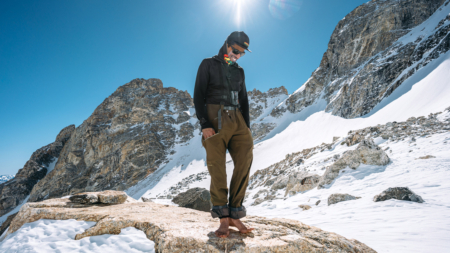The Relentless Push and Pull of a Mountain Guide
How Zahan Billimoria recalibrated after unthinkable tragedy.
On a cloudy day in mid-February 2016, Zahan Billimoria emerged from the darkness the only way he knew how: by skiing the remote mountains of northern Grand Teton National Park. That day, Zahan, an Exum Mountain Guide known as Z, and Nat Patridge, president of Exum and also a guide, skinned three miles across an ice-covered Jackson Lake, then climbed 5,000 vertical feet to the top of one mountain, another 1,000 vertical feet of ridge scrambling to a second peak, before skiing and skinning through the wilderness back to their car parked at Colter Bay. It was a 14-mile day, with a lot of complex route-finding, not much powder, little sunshine and no other people in a vast, untrammeled landscape.
Normally, this was exactly the kind of high-alpine adventure that Z lived for—the kind of day he’d worked so hard for so many years to have the fitness, skills and risk assessment to achieve—and why he and his wife had sacrificed the promise and prospect of jobs on the East Coast to live in small mountain towns with no guarantee of housing, health care or adequate income to raise a family.
But this tour brought Zahan, one of the strongest and most knowledgeable skiers and climbers in the Tetons, to his knees. Over the previous five years, he’d lost some of his most cherished friends, and ski partners. In 2010, his best friend, Wray Landon, died in an avalanche while skiing the South Teton. Two years later, Steve Romeo and Chris Onufer died in an avalanche while skiing a remote peak on the west side of Jackson Lake. In April 2015, A. J. Linnell was killed in a plane crash near Challis, Idaho. Then, in May, Zahan had been involved in a ski mountaineering accident on the north face of Mount Moran, also on the west side of Jackson Lake, where three of his friends, all fathers, had been struck by a cascading slough of snow as they climbed up a steep, icy couloir called the Sickle. Two of them died, leaving behind wives and children and a gaping wound in the Jackson community. This trip with Patridge marked the first time since that accident that Zahan had been back to the high alpine.
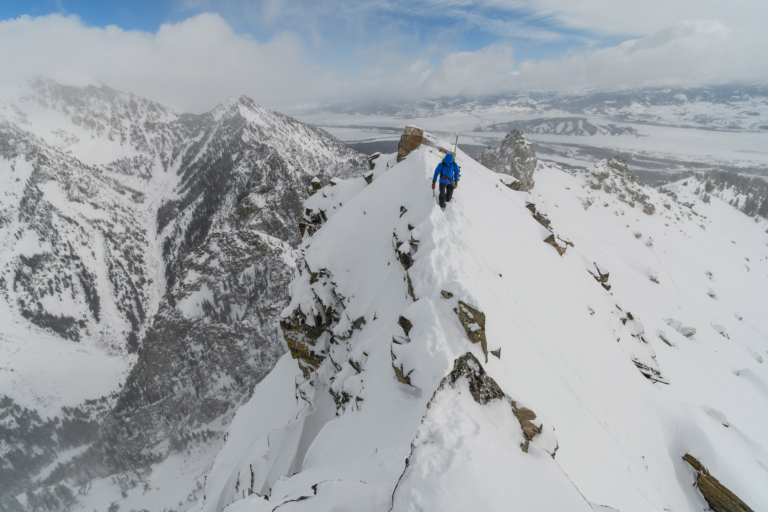
Zahan’s life walks the line between just enough risk and too much, with the balance always changing. There are no simple answers. Only a love for the mountains and bringing people into them. Teton Range, Wyoming. Photo: Fredrik Marmsater
On the way up, he and Patridge skinned past Romeo and Onufer’s final resting place. From the top of the mountains, they could see the Sickle, where friends Luke Lynch and Stephen Adamson had died despite Z’s best efforts to save them. Patridge, whose friend Hans Saari had been killed while they were on a ski trip in Chamonix in 2002, had for years battled his own demons in the aftermath of loss.
“Toward the end of the day with Nat, we were climbing this small couloir to gain the Eagle’s Rest Ridge,” Zahan, 42, said in a recent interview from his home in Jackson. “I was in the lead and booting up this couloir, gripped by terror and fear. I could not write any other narrative about the future that didn’t involve the mountain coming down and killing us. When we got to the crest of the ridge, my knees buckled and the world just totally came apart.”
Though painful, the experience helped Z gain the strength to move forward. It helped him recalibrate his relationships with the guiding profession, his wife and two children and the ever-important assessment of risk.
But the question that remained unanswered is how someone who’d built his life and bonds around a love for the mountains, and who’d seen so many friends perish in that environment, could continue to pursue such a tenuous path.
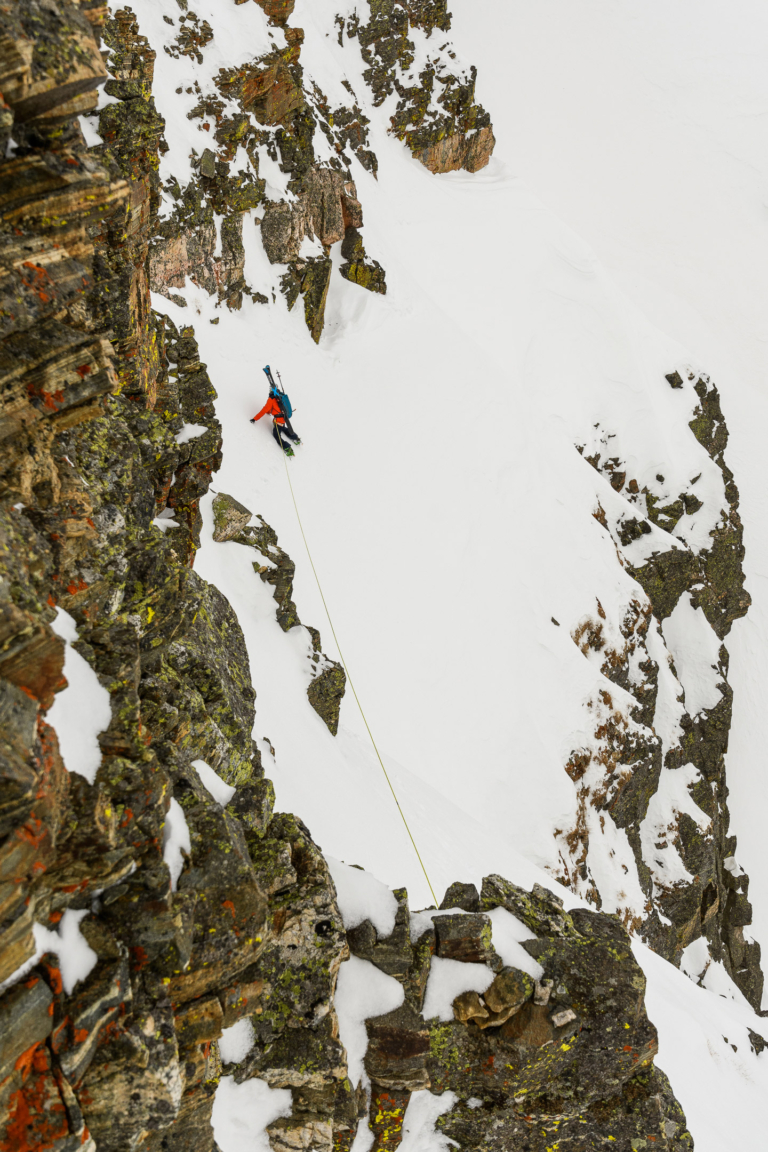
Out and about in the Tetons. Zahan’s dream of being a mountain guide started at age 18, when his parents linked him up with legendary French guide, Christophe Profit. From that point on, all compasses pointed towards Jackson until the day him and his wife, Kim, packed all their belongings and made the move to the Tetons. Photo: Fredrik Marmsater
In the years before and after 2010, Zahan was “chewing his arm off,” as he put it, five to seven days per week. That is to say, he relentlessly pursued his passion for being in the mountains—skinning, climbing, running—which naturally helped him make a name for himself as a guide in a community known for its long history of setting the standard for US mountain guides: Paul Petzoldt, Kim Schmitz, Bill Briggs, Alex Lowe, Doug Coombs, among many others.
At that time, Zahan and his wife, Kim, were living in Driggs, Idaho, the small rural town on the west side of the Tetons. They’d met as freshmen at Gordon College, a small liberal arts school near Boston. As they had both grown up outside the US—Zahan in Switzerland with Indian parents, and Kim in Tanzania with parents who were missionaries—they had a lot in common. “We met on the first day of our 8 a.m. international studies class,” Kim said. “To break the ice, you had to turn around to meet the person behind you, and when I turned around, the person behind me was Zahan.”
He was clean-cut. “We used to tease him about wearing sweater vests and gelled hair to class,” said Kim. Together, they pursued the outdoors, rock climbing and skiing on weekends.
At 23, Zahan led the outdoor program at an elite prep school north of Boston. But in Boston he wasn’t near the big mountains he’d dreamed of throughout his childhood. Just after high school, most of Zahan’s friends had been sent to party in Greece, but his parents knew that was a waste of money, so they offered to send him into the mountains instead. This decision landed him on a climbing trip with legendary French mountain guide Christophe Profit, an opportunity that solidified Zahan’s dream of making a life as a mountain guide. In Boston, that wasn’t going to happen, and Zahan understood that life was too short. He knew exactly what he had to do: move to the Tetons and become an Exum guide.
In 2003, Zahan and Kim packed their belongings and moved to Driggs. The short-term plan was to work at the Grand Targhee Resort, get season passes, and ski as much as possible. But by then, Zahan’s clean-cut image had vanished and, instead, he had long dreadlocks. Which Targhee refused to hire him for because they said dreadlocks didn’t meet their grooming standards.
To make a living, Zahan took on three jobs. He started the Z Language School, teaching Spanish to adults, mostly travelers or construction workers who wanted to be able to communicate better with Latino communities. With his gift for languages, he also worked for The Learning Academy, a kindergarten through fifth-grade school, in the Spanish program, and Teton Literacy in Jackson, teaching English to undocumented immigrants and other native Spanish speakers. Kim says Zahan has always shown great affection toward children—and as a person of color in an overwhelmingly white community, he felt a deep solidarity with his Latino students. His warm, caring side has always made him a natural teacher, whether the subject be language studies with kids, avalanche courses with ski bums or guiding adults up the Grand Teton. And in some ways, this same community spirit has kept him in the mountains—because even though it’s about the summits, and the adventures, for him it has always been about the people, too.
In 2005, his son, Alyosha, was born, and Zahan started competing in randonée races, eventually making the US Ski Mountaineering Team three years later. To improve his transition time between skinning and skiing, he asked Kim to time him racing back and forth across their backyard. At night.
“That was two seconds faster!” Kim would yell into the cold night, wearing a headlamp. “Great job!”
Meanwhile, he also started guiding for Yöstmark Backcountry Tours, a shop and guide service based in Driggs. But with a growing family, he knew he had to get a job with greater stability. He continued to “bang on Exum’s door” to no avail, and applied for a communications job with Jackson Hole Mountain Resort.
In 2009, the same week that the resort offered him the job, Exum sent him the coveted invitation to be a guide. He asked his boss at the ski area if he could do both. She said no. He did anyway, and started working seven days a week, driving over Teton Pass each day to get to work, a 70-mile round trip. On his way in, he’d meet Landon at 5:30 a.m. on the pass; they’d slap on headlamps and climb and ski as much vertical as possible before the workday started. Regardless of, but always accounting for, weather and conditions.
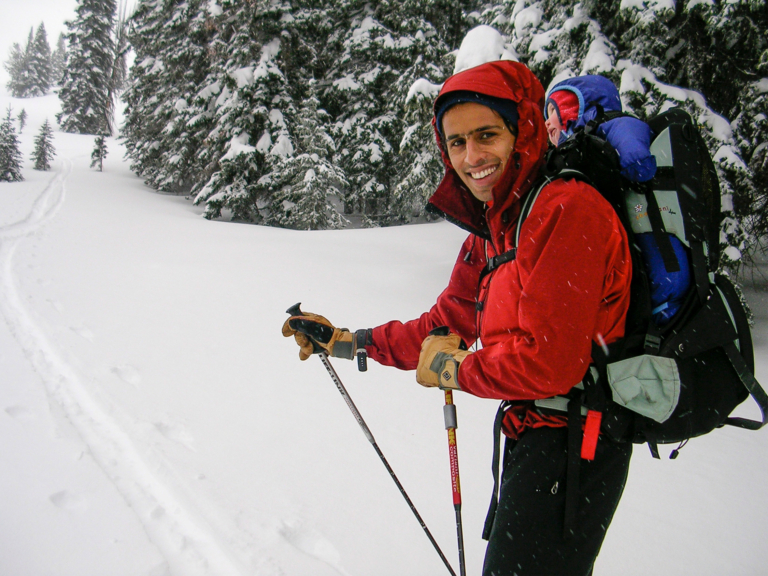
The perks of parenting. Zahan’s children, Alyosha and Gemma, join him in the mountains skiing, climbing and trail running. They always have; they probably always will. Photo: Zahan Billimoria Collection
The previous year, he and Kim had welcomed their daughter, Gemma, to the world. Full-time dad. Full-time jobs. Full-time commuting. Full-time skiing. It was an exhausting schedule, but Zahan was motivated. He was making moves, developing relationships in the ski industry while establishing his guiding style and clientele, and taking good care of his family.
Then, on Sunday, February 21, 2010, Landon died when an avalanche swept him off an 800-foot cliff on the South Teton. Landon and Zahan had become friends through running, and he’d been a huge influence on Zahan’s outlook on fitness in the mountains. A quiet and unassuming man who’d worked on conservation efforts in Idaho, Landon would literally run up the Grand Teton after work on summer evenings just to feel the sun-warmed rocks at the summit. For Z, this habit proved Landon’s superhuman endurance, but it also showed his attention to the small, delicate things that made him such a special companion.
At the time of Landon’s death, I was an editor for Powder magazine, getting ready for the title’s annual Powder Week ski test in Jackson Hole. Over the previous few months, I’d worked with Zahan to set up logistics for the 100 or so people planning to attend. I definitely noticed that Z, the resort PR guy, wore lightweight Dynafit touring boots while skiing Teton Village, and that despite such gear, he was still a better skier than I was. When he didn’t show that Sunday, I became annoyed. Then I heard the news about the avalanche, and when Z came into the demo tent on Monday, I could see the anguish all over his face.
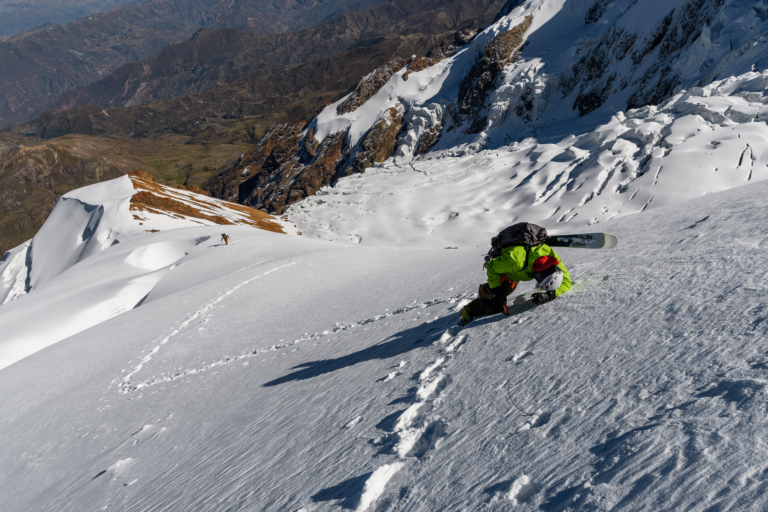
Sometime we all need a breather. Zahan taking one of his on his way up 6,438-meter Illimani. Cordillera Real, Bolivia. Photo: Fredrick Marmsater
Recalling the accident now, Zahan says Landon’s death was the first time he’d experienced the terrible consequence of risk, even though he hadn’t been skiing with Landon that day. Up until then, all his experiences in the mountains had been on the positive side of risk. He’d turned around plenty of times, but he’d never felt the crushing blow of how bad it could get if you made a mistake.
“That was the first time, at least as much as when Luke and Stephen died, that I really asked myself, Does this continue to make sense? Do you still want your life to be about this?” he said.
Deeply shaken, Zahan took the time to reflect on the accident and what it meant for his personal and professional goals. He decided that to become a skier who is fully capable of making the challenging, and often nuanced, decisions in the mountains, would mean eventually quitting his job at the resort and moving to Jackson to eliminate commuting, live closer to the big mountains he wanted to ski and to at last focus solely on guiding. To become the consummate mountain student.
Two years later, Romeo and Onufer died. Emotionally crushed, Zahan continued on his path, challenged, yet still restless. In 2012, Teton Gravity Research (TGR) hired him to teach its annual athlete- and film-focused avalanche course. Then TGR tapped him to be the lead guide for numerous films, including Jeremy Jones’s Deeper, Further, Higher series, during which he guided Jones down the Otter Body route on the Grand Teton, one of the most difficult and dangerous descents off the massif due to its extraordinary exposure.
That winter, his phone rang off the hook with people wanting to hire him to guide them down the iconic peak. “I could’ve booked back-to-back guided descents on the Grand all year long,” he said. “And I loved it. I thought I’d finally made it. I could ski the gnar every day all winter and get paid for it.
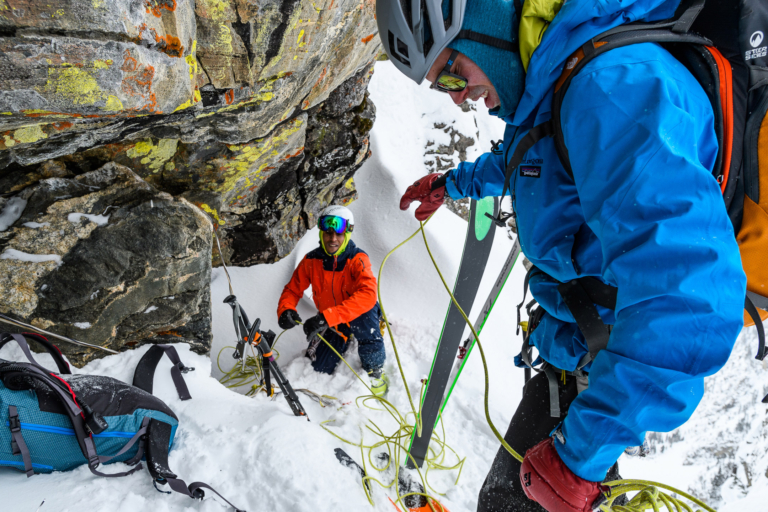
What’s a ski day without establishing anchors, rappelling and skiing on belay? Ben Hoiness and Zahan Billimoria out for some proper Teton fun. Grand Teton National Park, Wyoming. Photo: Fredrik Marmsater
“Now, I’m like, let me think about it.”
Like music, boot-sole length and the taste of anchovies, risk tolerance is a very personal thing; you can’t tell someone to love reggae (of which Zahan is a passionate devotee); you can’t make someone fit into any old boot; and you can’t put anchovies on just anyone’s salad. But while these things won’t kill you, the mountains will, and yet the only person deciding how much risk is too much is the one taking the step. People may argue over decisions, and there are certainly external factors—family, kids, personal obligations—that should be weighed during any pursuit deemed potentially hazardous.
Finding balance might come down to a question of how much a person is willing to gain versus how much he or she has to lose. But risk is complicated; it makes life exciting, but can end it in a heartbeat. The answers aren’t simple. But there are plenty of people who have decided that it was no longer worth it. In Jackson alone, there are two elected county commissioners who have moved beyond a life of risk in the high peaks to pursue the hectic and volatile world of resort-town politics: Mark Newcomb, a pioneer of so many of the big lines in the Tetons in the ’90s; and Greg Epstein, a former TGR producer who nearly died in an avalanche in Jackson Hole’s lift-served backcountry.
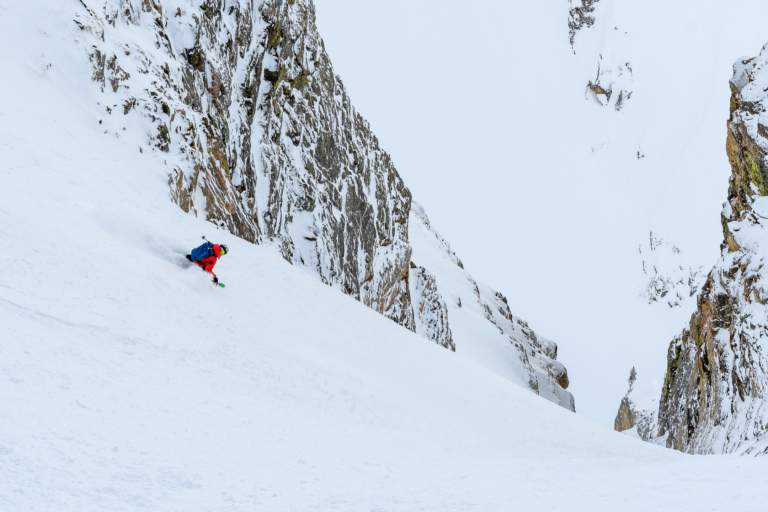
Isn’t life grand? Zahan Billimoria shredding in “the park.” Grand Teton National Park, Wyoming. Photo: Fredrik Marmsater
Zahan knows as well as anyone that skiing in the Tetons is objectively hazardous. In the high alpine, there are no runouts, just thousands of vertical feet of exposure. If you misread the conditions, or make a slight error, the consequences can be disastrous, as Zahan experienced with the Moran accident. “It doesn’t take much to have a consequential accident in big mountains. But even if you take all the precautions, sometimes you just have bad luck.”
The problem with skiing in avalanche terrain, he said, is that the only feedback you ever get is the kind that can kill you. “In all accidents, it’s always someone misreading the situation, including my own at the time,” he said. “But just how much you misread the conditions does not necessarily correlate to the outcome. You could misread it just a tiny bit and have a deadly outcome. Or you could’ve screwed up royally and gotten away scot-free, be pounding beers at the bar later and be none the wiser.”
During the summer, I often see him out on the local bike trails with Alyosha and Gemma. In winter, he takes them backcountry skiing to impart to them his love of wilderness. Alyosha likes hitting jumps at the ski area. Gemma likes to dance and ride horses. When I asked him about whether he talks to his kids about risk in the mountains, he shook his head.
“They already know too much,” he said. “They’ve already been to too many wakes and funerals.”
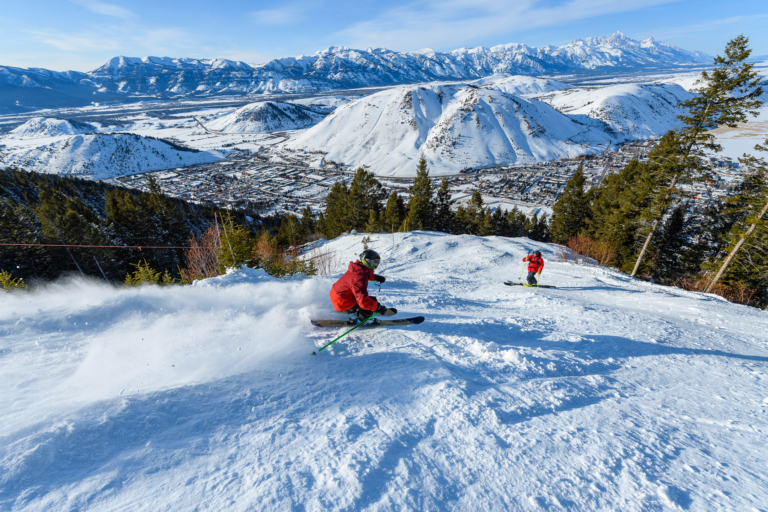
Let ‘em rip. Zahan his son, Alyosha, ripping around the backyard at Snow King Mountain. Jackson, Wyoming. Photo: Fredrick Marmsater
Though he says he now enjoys the human interaction in the mountains just as much as the wild terrain, he continues to seek the occasional radical agenda. He’s in a constant state of push and pull: How can he pursue adventures in big mountains while making sure he’s not overextending himself? In the spring of 2019, on a gloriously blue day in Jackson, I ran into Zahan skinning up Snow King Mountain, Jackson’s steep town hill. He told me he was planning a trip and pulled out his phone to show me a photo of an enormous, fluted face on a 21,000-foot mountain in Bolivia.
A few months later, he and a small crew tried to climb and ski the face as part of a mission to ski five peaks in two weeks. Fewer than 100 feet from the summit of this one peak, they turned around due to lightning. They still skied the other four.
I asked him why, given all that he has been through, he would choose to go to Bolivia to ski dangerous mountains in the middle of nowhere. He looked at me and gave the simplest, but most telling, explanation of all.
“Because I love it,” he said.

Struggling with altitude and stomach problems, but still skiing, Zahan Billimoria on the normal route of 6,438-meter Illimani. Cordillera Real, Bolivia. Photo: Fredrick Marmsater
A couple times a week during the winter, Zahan meets two friends at 5:30 a.m. at the base of Snow King. They go out with headlamps and pin it, bootpacking and skinning up the 1,571-vertical-foot mountain as fast as they can. They go so hard and so fast they can’t breathe and their eyes pop out of their heads. After an hour or so, they wrap it up and head back home in time to make breakfast for their families, like golden retrievers who just chased the tennis ball a thousand times and can now relax.
And yet, he’s still a big-mountain alpinist whose deep desire to explore windswept ridgelines and complex terrain can’t be satiated by a small ski hill alone. During the coronavirus-shortened winter of 2019-20, Zahan skied in British Columbia, the Wasatch, Italy and Austria. In BC, two close calls a week apart brought him back to the crushing reality of what can happen when you misread the conditions.
“There are no simple answers to surviving a life in big-mountain terrain,” he said. “If you don’t persist, you might end up skiing low-angle powder all the time. And that might be fine if that’s how you’re wired. But if you’re wired like I am, I’ve always wanted something bigger, something more complicated, something scarier. Then you’re going to have to balance that persistence with finding a way through with the willingness to accept reality for what it is. Not force it.”
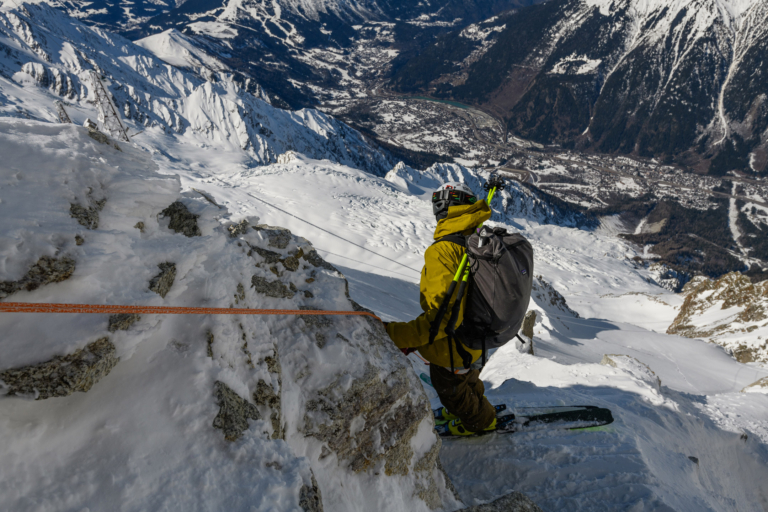
Back to where it all started—the Alps. Zahan grew up in Switzerland and was influenced by his father’s own love of the mountains. Skiing the Galcier Rond, Chamonix, France. Photo: Fredrik Marmsater
In BC’s Coast Mountains, he admits, he forced it. A week of bad weather had closed his skiing options. When it opened back up, he says, he let his mind and emotions write the script instead of the mountains. And this miscalculation led to a narrow escape.
“I’ve spent the last 15 years of my life wrapping my head around the mountain environment,” he said. “These accidents make me think I need to spend the next 15 wrapping my head around the human environment.”
In the days, weeks and months since BC, he continues to grind away at the emotional and physical challenges that come with being a skier with a family who seeks answers by going into the mountains. Now, instead of rushing to the next big adventure, he lets the feeling linger for a few days while he goes to Alyosha’s soccer games or takes Gemma horseback riding.
Kim, who has been with him for all of it, maintains her support.
“I’ve come to a place where he’s so passionate and it feeds his soul in such a deep way that I would never ask him to not take that risk,” she said. “I believe that he has honed his skills and is applying himself to be as safe as possible, knowing he is a fallible human being in an untamed environment. But he also brings so much joy to other people he’s with. It’s a powerful combination, so I support it.”
Zahan has also launched Samsara Experience, a community-based training platform for high performance athletes. His method is rooted in the science of movement, and the study of the fascia system and he has developed a setting aimed at transforming strength and endurance mountain athletes. It all takes place in his immaculately organized garage that he’s turned into his own “dojo.” A custom-designed climbing wall features 130 holds. Ropes and other equipment hang perfectly on hooks. Samsara, an Indian word that refers to the cycle of death and rebirth, is what he calls a “handrail” to the future, something he can hold onto that takes some of the pressure off high-alpine pursuits.
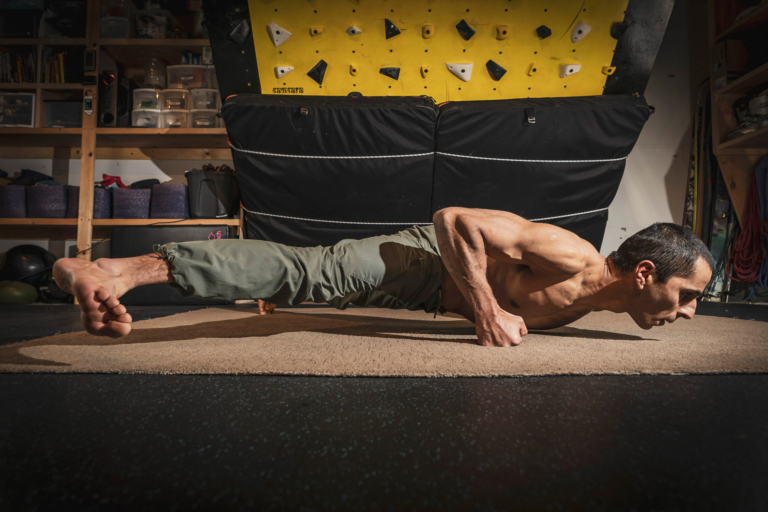
Who wouldn’t take a strength lesson from this guy? Samsara Experience, Zahan’s training platform is geared toward high-performance athletes, and honing in on an “athletic IQ,” which is “what makes hard movement ‘look easy’— the hallmark of athleticism.” Photo: Adam Wirth
Last winter, between sessions on the wall, he told me he’s still searching for proper balance.
“I am going to seek out wild places and big exposed terrain, knowing that my team, my skills, fitness, ski ability, all those things are being drawn upon to pull a mission off. I’m still seeking that.
“Tomorrow, we’re going to ski the Grand. I think it’s a bit premature, but if we can go in the mountains with that mindset and go poke around, it’s easy to turn around. But sometimes you get lucky, and if you’re in the right spot, you can go for it.”
